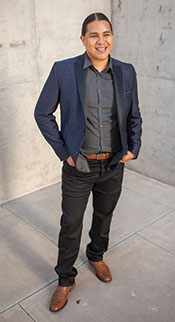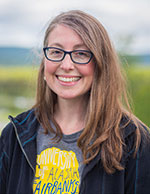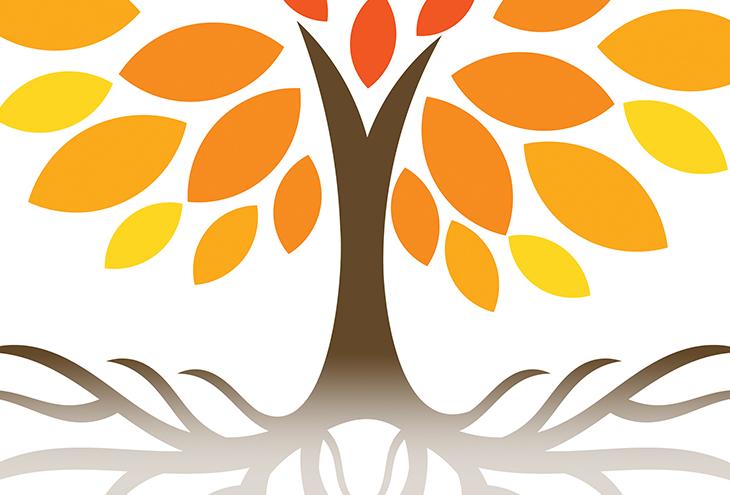For most students, the prerequisites for academic success include more than intro courses. To do well in a rigorous campus environment, students need a strong safety net of support that includes like-minded friends, effective mentors, and cultural affirmation.
There’s plenty of research reinforcing the idea that on-campus support — like an AISES College Chapter — plays a crucial role in helping students stick to their academic paths. An article in the Journal of Developmental Education, for one, points out that the most effective of these networks have even more “retention strategies” in place. Those ancillary factors can include pre-college academic preparation, family and faculty support, social support systems in the form of American Indian/Alaska Native student associations, multicultural offices, peer mentoring programs, academic counseling, and cultural ceremonies Universities that call upon multiple resources see more students staying in school, doing better academically, and completing their degrees.
Of course, some students are able to create their own support system, but others find that when there’s a built-in resource, they do much better. If you’re in this group, you’ll find many schools ready to welcome you with programs and organizations already in place. Here’s a look at just some of them.
FINDING A PLACE

When Jameson D. Lopez stepped onto the campus of one of the country’s largest universities, he felt lost. “When I first arrived at Arizona State University’s College of Education, all the Native faculty had moved on,” he recalls. “I had to go out of my way to find any other Natives.”
Fortunately, Lopez, a member of the Quechan Tribe from the Arizona-California border who is pursuing a doctorate in education, found his way to ASU’s American Indian Student Support Services (AISSS). “I wandered into this lady’s office and started talking to her,” he says. “She had a lot of brochures for Native student services. After about a half hour of talking with her, I said, ‘I should know who you are.’” The helpful lady turned out to be Diane Humetewa, who at the time was the special advisor on Native American affairs to ASU President Michael Crow — she would go on to become the first Native American federal judge.
For Lopez, the encounter marked the beginning of his successful graduate school journey. “I introduced myself to the AISSS director, Dr. Laura Gonzales-Macias, and I met Native faculty,” he says. One of those professors, Dr. James Riding In, was especially helpful. “We’re both veterans, and even though he has no direct links with my program, he’s just interested in helping me.”
ASU’s Native support services include hosting more than a dozen student organizations that give the university’s 1,200 Native students a home away from home and offer mentoring by local Native professionals. There’s also the SPIRIT program, or Student Preparedness Initiative: Readiness Inspired by Tradition, a two-week session held before the start of the fall semester for first-time freshmen. Many of the students that SPIRIT reaches are away from their remote reservation homes for the first time, facing the challenge of adjusting to campus life, gaining new friends, and identifying possible mentors.
Ultimately, the school’s American Indian student and academic programs are designed to result in more Native graduates, says Annabell Bowen, Diné and Seneca, ASU’s director of American Indian Initiatives. Accomplishing that goal involves a school-wide network. “We build student success initiatives with partners across campus in areas such as financial aid, admissions, and academic departments,” she says.
Lopez is continuing to benefit from ASU’s support services, and recommends that other Native students make these offices one of their first stops. “They’re now helping my nephew, Cody Gonzalez,” he adds. “The Quechan Tribe is a dual-state tribe, and Arizona offers all members the in-state tuition rate, no matter which side of the Colorado River they live on. ASU helped Cody obtain his waiver for in-state tuition so he can go to college, too.”
WRAPPING STUDENTS IN SUPPORT

Since 1969, Humboldt State University in Northern California has taken an interdisciplinary approach to wrapping services around its Native students. “California has the most Natives in the U.S., and the densest population is here in Northern California,” says Lonyx Landry, Nor Rel Muk Wintu, STEM advisor for the Indian Natural Resources, Science, and Engineering Program, or INRSEP. These tribes, which managed to keep most of their cultures intact during the worst atrocities committed in the 19th century, banded together in a grassroots effort to initiate a teacher education program at HSU. That program, now known as the Indian Tribal and Educational Personnel Program (ITEPP), is one of the nation’s oldest initiatives serving Native students.
“In addition to our Native American Studies Program, we have ITEPP and INRSEP to provide support,” Landry explains. There’s also the Council of American Indian Faculty and Staff, which ties in many colleagues and programs and provides opportunities to work together. Landry points out, “We work with tribes and Indian organizations locally and beyond to generate opportunities by complementing each other’s programs.”
For students, these connections can mean expanded options. “INRSEP is a great way to find out about opportunities that most people don’t hear about,” says Antoinette Shirley, Navajo, a senior zoology major. Shirley was able to spend two summers working with the Navajo Nation Department of Fish and Wildlife, thanks to HSU's programs that facilitate connections with tribes and other organizations.
"These jobs also allow students time and space to investigate their ancestry and their role as Native people," says Landry. When Landry suggested that Shirley, who was born and raised in the San Francisco Bay Area, do some research on her tribe, she was interested in not only doing science for her people but also the chance to learn more about her tribe. "He knew that I wanted to get more involved with my tribe and learn more about it, so he helped me formulate a question that enabled me to get the position," says Shirley.
Besides academic and other program services, Humboldt and the campus's Native community also support a rich cultural life for the student body, including a Big Time each spring. An intertribal gathering unique to California tribes, a Big Time brings together dance and song groups, cultural demonstrations, and traditional foods from around the state. Last year’s Region 1 and 2 AISES Regional Conference was scheduled to coincide with the Big Time, resulting in the largest regional gathering ever, Landry says.
Students can also choose on-campus living with a cultural focus. HSU’s Native American Living Suite is open to any student interested in Native cultures and values.
“We built our reputation as the best university for Natives between Washington and Arizona on all these things working together,” Landry says. “Our Native students, and the entire campus, benefit.”

HOME AWAY FROM HOME

The University of Alaska Fairbanks reaches out to ensure the success of the nearly 2,000 Alaska Natives attending the school, whose total enrollment tops 9,000. “We work to create a family away from home,” says Gabrielle Russell, lead advisor for Rural Student Services (RSS). “Being in a new, unfamiliar environment is a challenge for many of our students.” And it’s made harder because a ticket for round-trip airfare home to their remote communities in Alaska can cost up to $1,200, she says. “We attempt to provide support and resources to help our students overcome the homesickness many of them go through.”
Celebrating Alaska Native cultures is one strategy. “We have Positive Connection Nights on Fridays throughout the semester where we have some sort of home-cooked meal with food supplied by our faculty and staff,” Russell says. There are also several culturally related student organizations, such as the Inu-Yupiaq and Troth-Yeddha’ dance groups.
Like HSU’s Native support system, UAF’s RSS program was formed in 1969. Although many students receive funding from one of 13 Alaska Native Regional Corporations to help with college expenses, they may still need assistance with other financial services, and RSS is there to help with navigating the financial aid maze. The program also helps with tutoring, housing options, and career exploration.
Student organizations such as the UAF AISES College Chapter and clubs for students planning a career in education, social work, business, or engineering are also helpful. “Students tend to be more successful when they’re involved with these types of clubs and organizations during their college experience,” Russell says.
A supportive residence hall choice is the Eileen Panigeo MacLean House, which provides students from the Arctic region and other remote areas with the same sort of small, tight-knit community they came from, a buffer to the fast-paced university and bustling city life in Fairbanks.
Russell notes that many Alaska Native organizations and corporations want to support their tribal members who are attending college. RSS has a venue for organizations to meet with their tribal members and also helps facilitate events — such as the Festival of Native Arts, which is held annually at UAF — to help build those relationships.
For a directory of colleges and universities with an AISES College Chapter, visit aises.org. If your school doesn’t have a chapter already, consider starting one.













